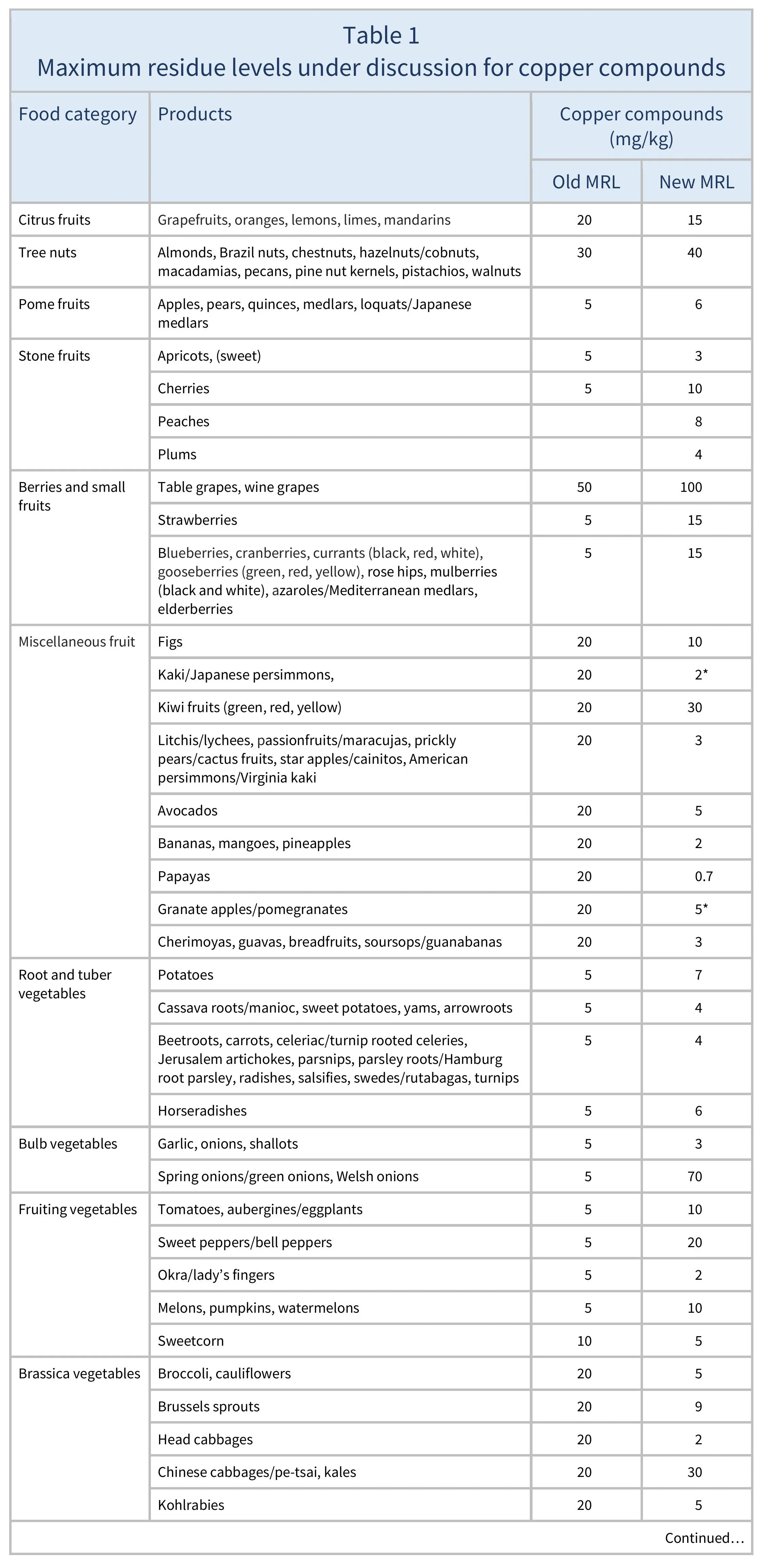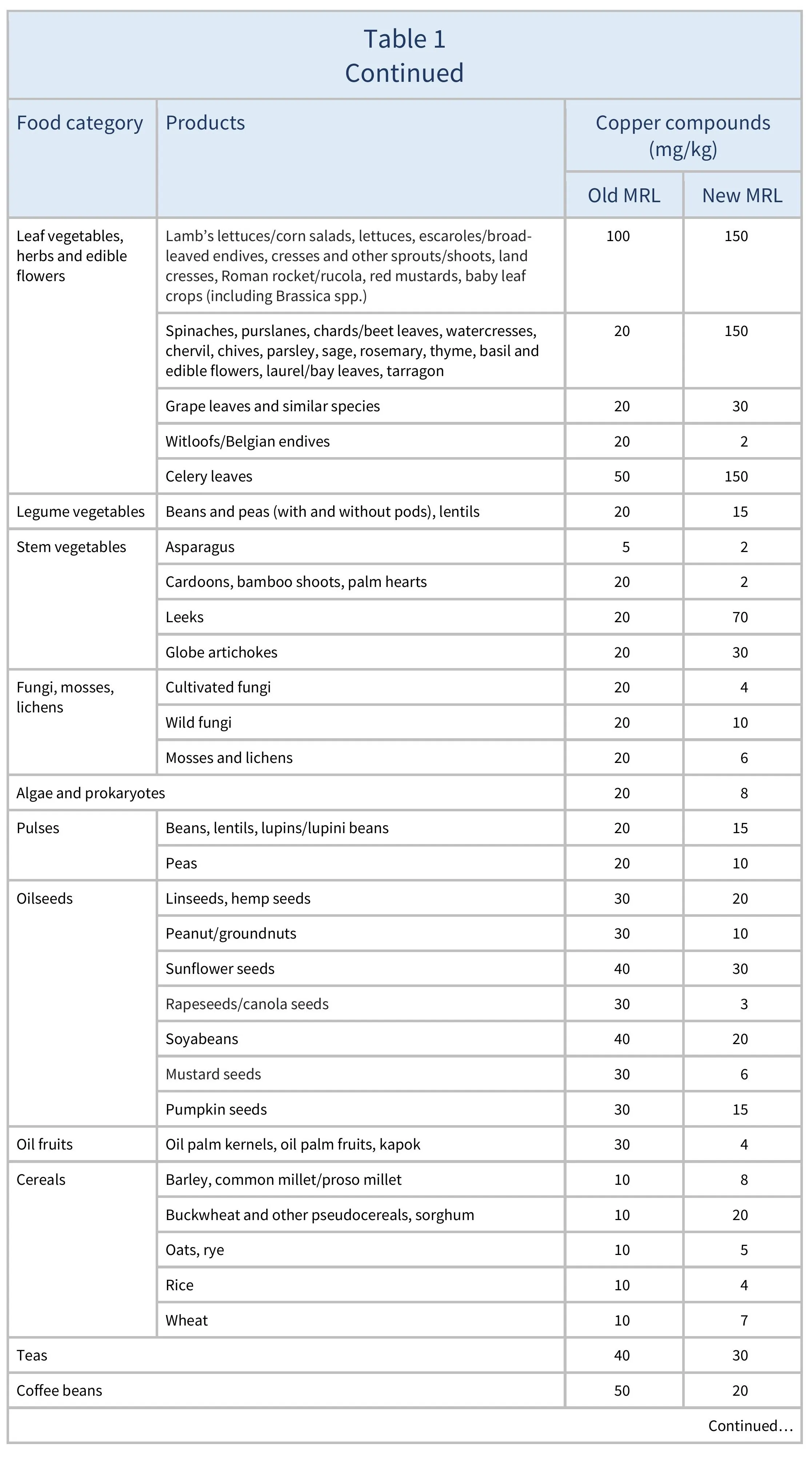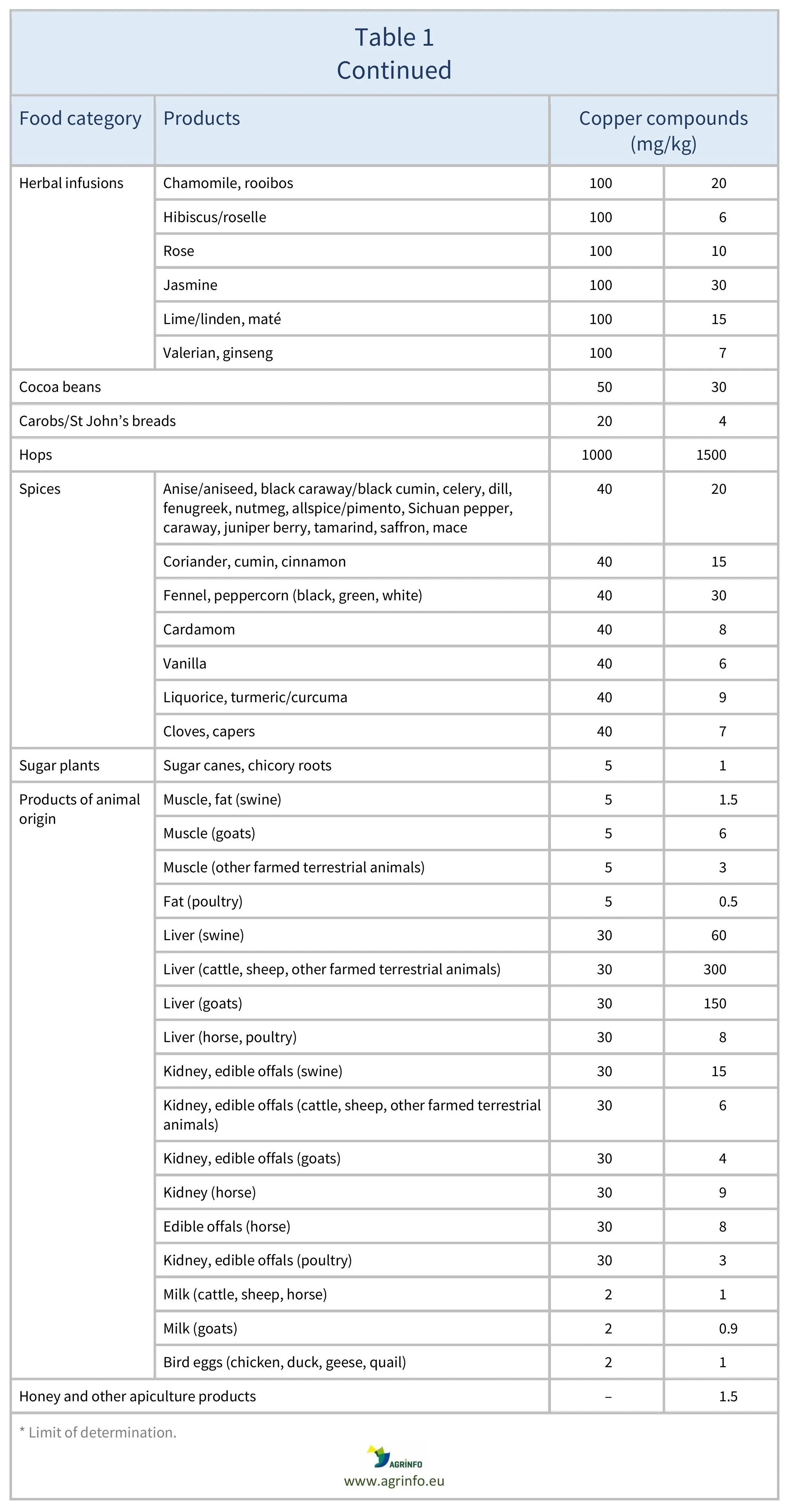Maximum residue levels for copper compounds
- Food safety
- Pesticide MRLs
Summary
The European Union (EU) is discussing its review of maximum residue levels (MRLs) for copper compounds. Initially, this included reducing the MRLs on a wide range of products.
However, in October 2025, it was agreed that the Commission should continue with drafting a Regulation that would only include raises in MRLs; reductions in MRLs will be regulated at a second stage, once data is available that will provide a more robust basis for setting these MRLs.
EU discusses revision of MRLs for copper compounds
Draft Commission Regulation amending Annexes II and III to Regulation (EC) No 396/2005 of the European Parliament and of the Council as regards maximum residue levels for copper compounds in or on certain products [download]
Draft Annex II [download]
Update
The European Union (EU) is discussing its review of maximum residue levels (MRLs) for copper compounds. Initially, this included reducing the MRLs on a wide range of products.
However, in October 2025, it was agreed that the Commission should continue with drafting a Regulation that would only include raises in MRLs; reductions in MRLs will be regulated at a second stage, once data is available that will provide a more robust basis for setting these MRLs.
Impacted Products
Grapefruits, oranges, lemons, limes, mandarins, almonds, Brazil nuts, chestnuts, hazelnuts, macadamias, pecans, pine nut kernels, pistachios, walnuts, apples, pears, quinces, medlars, loquats/Japanese medlars, apricots, cherries, peaches, plums, table grapes, wine grapes, strawberries, blueberries, cranberries, currants (black, red, white), gooseberries (green, red, yellow), rose hips, mulberries (black and white), azaroles/Mediterranean medlars, elderberries, figs, kaki/Japanese persimmons, kiwi fruits (green, red, yellow), litchis/lychees, passionfruits/maracujas, prickly pears/cactus fruits, star apples/cainitos, American persimmons/Virginia kaki, avocados, bananas, mangoes, pineapples, papayas, granate apples/pomegranates, cherimoyas, guavas, breadfruits, soursops/guanabanas, potatoes, cassava roots/manioc, sweet potatoes, yams, arrowroots, beetroots, carrots, celeriac/turnip rooted celeries, Jerusalem artichokes, parsnips, parsley roots/Hamburg root parsley, radishes, salsifies, swedes/rutabagas, turnips, horseradishes, garlic, onions, shallots spring onions/green onions, Welsh onions, tomatoes, aubergines/eggplants, sweet peppers/bell peppers, okra/lady’s fingers, melons, pumpkins, watermelons, sweetcorn, broccoli, cauliflowers, Brussels sprouts, head cabbages, Chinese cabbages/pe-tsai, kales, kohlrabies, lamb’s lettuces, lettuces, escaroles, cresses and other sprouts and shoots, land cresses, Roman rocket/rucola, red mustards, baby leaf crops, spinaches, purslanes, chards/beet leaves, watercresses, chervil, chives, parsley, sage, rosemary, thyme, basil and edible flowers, laurel/bay leaves, tarragon, grape leaves and similar species, Belgian endives, celery leaves, beans and peas (with and without pods), lentils, asparagus, cardoons, bamboo shoots, palm hearts, leeks, globe artichokes, cultivated fungi, wild fungi, mosses and lichens, algae and prokaryotes organisms, beans, lentils, lupins, peas, linseeds, hemp seeds, peanuts/groundnuts, sunflower seeds, rapeseeds/canola seeds, soyabeans, mustard seeds, pumpkin seeds, castor beans, oil palm kernels, oil palm fruits, kapok, barley, millet, buckwheat, sorghum, oat, rye, rice, wheat, rye, sorghum, wheat, chamomile, rooibos, hibiscus, rose, jasmine, lime, maté, valerian, ginseng, aniseed, black cumin, celery, dill, fenugreek, nutmeg, allspice/pimento, Sichuan pepper, caraway, juniper berry, tamarind, saffron, mace, coriander, cumin, cinnamon, fennel, cardamom, vanilla, liquorice, turmeric/curcuma, cloves, capers, sugar canes, chicory roots, fat (swine, poultry), muscle (swine, goats, other farmed terrestrial animals), liver (swine, cattle, sheep, goats, horse, poultry, other farmed terrestrial animals), kidney and edible offals (swine, cattle, sheep, goats, horse, poultry, other farmed terrestrial animals), milk (cattle, sheep, horse), milk (goat), bird eggs (chicken, duck, geese, quail), honey and other apiculture products, cocoa beans, carobs/St John’s breads, hops, teas, coffee beans
What is changing?
The EU is discussing the amendment of MRLs for copper compounds on certain products, as summarised in Table 1.
However, in October 2025, the Commission and EU Member States agreed that the Commission should continue with drafting a Regulation that would raise copper compound MRLs on certain products (in line with Table 1), but should postpone the reduction of MRLs to a second stage, once data is available that will provide a more robust basis for setting these MRLs (Commission, 2025).
Why?
The discussion is based on updated scientific assessments by the European Food Safety Authority (EFSA 2025), which reviewed all sources of exposure and considered both authorised uses of copper as a pesticide and the widespread natural presence of copper in soil and water.
Timeline
The first Regulation raising MRLs is still under discussion and is expected to be adopted in 2026.
Background
MRLs are set in accordance with the rules set out in Regulation 396/2005. For information on current MRLs for other substances, please consult the EU Pesticide Residues database.
Resources
EFSA (2025) Statement on the update of maximum residue levels (MRLs) for copper compounds in light of the EFSA scientific opinion on the re‐evaluation of the health‐based guidance values (HBGVs) and exposure assessment from all sources. EFSA Journal, 23(2): e9271.
European Commission (2025) Summary Report, Standing Committee on Plants, Animals, Food and Feed Section Phytopharmaceuticals – Pesticide Residues 2 - 3 October 2025.
Sources
Draft Commission Regulation […] as regards maximum residue levels for copper compounds in or on certain products [download]
Draft Annex II [download]
Tables & Figures
Disclaimer: Under no circumstances shall COLEAD be liable for any loss, damage, liability or expense incurred or suffered that is claimed to have resulted from the use of information available on this website or any link to external sites. The use of the website is at the user’s sole risk and responsibility. This information platform was created and maintained with the financial support of the European Union. Its contents do not, however, reflect the views of the European Union.
EU discusses revision of MRLs for copper compounds
Draft Commission Regulation […] as regards maximum residue levels for copper compounds in or on certain products [download]
Draft Annex II [download]
What is changing and why?
The European Union (EU) is discussing the amendment of maximum residue levels (MRLs) for copper compounds on certain products, as summarised in Table 1. This is based on updated scientific assessments by the European Food Safety Authority, which reviewed all sources of exposure (use as a pesticide and natural presence in the environment).
Timeline
In October 2025, the EU decided that at a first stage the new Regulation should only include increases in MRLs. MRL reductions will be regulated at a second stage, when more robust data is available.
The first Regulation raising MRLs is still under discussion and is expected to be adopted in 2026.
Tables & Figures
Disclaimer: Under no circumstances shall COLEAD be liable for any loss, damage, liability or expense incurred or suffered that is claimed to have resulted from the use of information available on this website or any link to external sites. The use of the website is at the user’s sole risk and responsibility. This information platform was created and maintained with the financial support of the European Union. Its contents do not, however, reflect the views of the European Union.



